Hurunui and Waiau Uwha Braided River Bird Project
The Hurunui and Waiau Uwha Braided River Bird Project began in 2017 and aims to to protect and enhance habitat for black-fronted terns and black-billed gulls on the Hurunui and Waiau Uwha Rivers.
Focus has been on protecting and monitoring success rates of nests for these species, to see which methods of protection are working. The Department of Conservation (DOC) has contributed a significant amount of resource to support this project, through monitoring and weed control.
Funding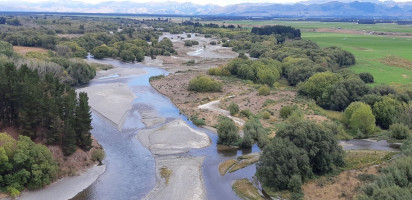
Between 2017 and 2022, around $40,000 per year in biodiversity funding allowed trapping, weed control and monitoring at both rivers.
Environment Canterbury, the Hurunui District Council and rūnanga have recently endorsed an additional $50,000 of funding to continue supporting the programme for the 2022/2023 season. Staff are currently working on the funding agreement and project implementation with the Department of Conservation.
Find out more
Project background
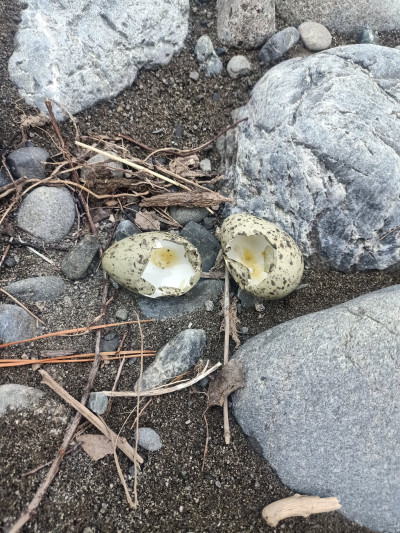
Two black-fronted tern eggs after being preyed on
In 2017, the previous Hurunui Waiau Uwha Zone Committee approved a new priority area - braided river ecosystems - with a particular focus on the main stems of the Hurunui and Waiau Uwha rivers.
The previous committee hosted a meeting of braided river experts to identify the key values, threats and gaps for braided river biodiversity management and indicated a need for a strategic management approach to address the multitude of threats facing our braided river birds, such as the black-fronted tern and black-billed gulls.
The previous committee then decided on a set of strategic, focused and applied on-the-ground biodiversity actions which formed the basis of their flagship project.
These projects were then implemented in partnership with the Department of Conservation, community groups and landowners to:
- raise the awareness of braided riverbed values
- trial new techniques, and
- provide an adaptive management approach.
These actions have increased the knowledge and understanding of the braided river systems, helping staff and partners improve protection methods for braided river bird habitat.
Project vision
A thriving, natural, dynamic braided river environment, which protects the biodiversity values present, recreational and amenity opportunities are plentiful, and all key stakeholders are actively engaged in braided riverbed biodiversity management.
Community support needed
The project has been supported by landowners and community in the Hurunui District and there's always opportunities for more people to be involved.
We are seeking funders, partnerships and collaborations with any interested landowners, community groups, or agencies to build on what has been done and ensure that all braided river habitat and biodiversity values on the rivers are protected and maintained for future generations.
Phase one - finding an approach that works
Phase one from 2017 to 2022 saw those in the project go from knowing very little about the unique braided river ecosystems in the Hurunui and Waiau Uwha rivers, to now having a better picture on how to best protect the braided river birds that call these waterways home.
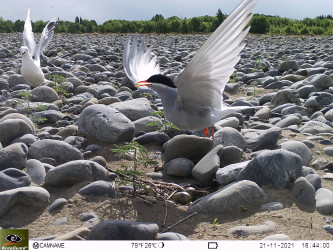
A black-fronted tern protects its nest
Actions undertaken across the first five-years of the project included:
- pest control
- habitat island enhancement - ensuring deep river channels around habitat islands to stop pests from swimming across the channels
- clearing vegetation/weed control
- trapping with a 'ring of steel' - predator traps set around nesting sites in a ring formation
- monitoring breeding outcomes of braided river birds.
There was an assumption southern black-backed gulls were one of the major predators around these rivers, as they are known to be in others. This meant the southern black-backed gulls were initially the focus of control efforts. However, no predation incidents involving the southern black-backed gulls were recorded over five-years of monitoring in phase one, despite their high population in the area.
Monitoring instead, found eggs and adult birds in the non-treatment areas being eaten by mustelids, cats, rats and hedgehogs, before the chicks had a chance to hatch.
High intensity trapping around one enhanced island was found to support higher success rates for braided river bird breeding, so the project team re-focused their efforts on higher intensity trapping, as opposed to targeted species trapping.
The learnings gained through the first phase of the project has helped shape future actions in a way that will better protect the braided river birds.
2022 is a bridging year, with further predator and weed control taking place, before phase two starting in 2023.
Phase two - continuing efforts
Focus for stage two (2023) is likely to be around future management of two key islands – NIWA Island on the Hurunui River and Sharkstooth Island on the Waiau Uwha River.
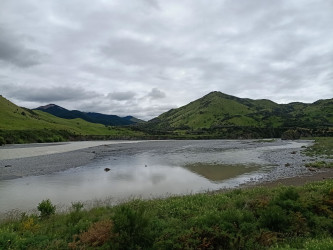
Sharkstooth Island on the Waiau Uwha River
Actions include:
- enhancing both islands by ensuring deep channels on both sides
- clearing vegetation/weed control
- putting a ring of steel around the islands - predator traps set around nesting sites in a ring formation
- undertaking aerial predator control as needed and feasible, and
- monitoring the breeding outcomes of the birds.
2022 breeding season
The braided river birds breeding season is about to begin on the Hurunui and Waiau Uhwa Rivers.
Following on from the previous five years, work is underway by Environment Canterbury to protect black fronted terns during this critical stage in this internationally significant habitat.
Earthworks were completed on NIWA Island in Hurunui to create a new channel along its northern boundary, intended to prevent predators that threaten eggs and chicks on the island from crossing.
A weed control day was recently organised with Environment Canterbury staff and community volunteers clearing some of the weeds on the island.
Earthworks at Sharkstooth Island on the Waiau Uhwa have created a raised island to provide improved breeding habitat for birdlife. Traps will now be installed along the banks of the river and on the islands themselves. The predator control and monitoring work will continue throughout the season.
It's hoped the work will contribute to a successful breeding season for these threatened birds on the two islands this year.
For more information, please get in touch. Also, keep an eye out for details on an upcoming field day with the Hurunui Biodiversity Trust.
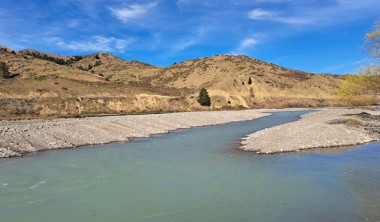
New channel at NIWA Island.
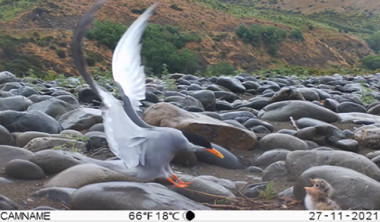
Black fronted tern feeding a chick.
Image credit to Zipporah Ploeg and Wildlife Management International.
